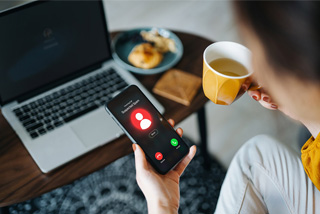
Essential tips for preventing check fraud

What is financial fraud?

December 20, 2024

It happened one day in September. Jim, a retired aerospace test manager who lives in the San Diego area, received an alarming email that appeared to be from his bank.
“Urgent! Call U.S. Bank immediately!” the message said.
Understandably concerned about what was going on, Jim dialed the number on the email, and a man named Daniel answered — though Jim knows now that probably wasn’t his real name. “Daniel” turned out to be a scammer who was trying to trick Jim out of his money.
The events that followed gave Jim a first-hand lesson in just how clever and persuasive scammers can be. He learned what signs to watch out for, and now relays his story to friends and family every chance he gets to help them avoid the same headaches he experienced.
The man on the phone that day, “Daniel,” claimed to work at U.S. Bank in the accounting department at the bank’s headquarters in Minneapolis. The man sheepishly explained to Jim that he’d accidentally transferred $1,000 into Jim’s bank account and needed Jim’s help to correct the error before his boss found out.
“I’m a family man, and I have kids to feed and a mortgage to pay,” Jim remembers the man saying on the other end of the phone line. “I can’t get fired over this honest mistake!”
The man went on to beg Jim to help him save his job by purchasing gift cards to be sent to the man. He assured Jim that the funds from those gift cards would be used to credit the money to the correct accounts, fixing the error.
Jim admits that he was initially skeptical of the request, but the man seemed to have a convincing response to every question or concern that Jim raised. Jim looked at his bank account online using a link in the man’s email and saw that a $1,000 deposit appeared to have been made into his account, lending even more credibility to the man’s story. And what really struck Jim the most was the fact that the man sounded genuinely upset about the possibility of losing his job over a simple error.
Jim, an active member of his church and a volunteer at a local hospital, is the kind of person who always wants to do what he can to help others in need. So he agreed to the man’s instructions, purchasing gift cards and sending them to the address the man gave him.
Unfortunately, the man wasn’t a U.S. Bank employee. He turned out to be a scammer who used an emotional story to play right into Jim’s kind and caring nature, leading Jim to experience a $1,000 financial loss that day. Making matters worse, the man tricked him into clicking on a website that looked like U.S. Bank’s online banking page. But, in fact, it was actually a spoofed website designed to capture Jim’s online banking username and password to help the fraudster gain access to Jim’s accounts.
“It sounded so real,” says Jim. “The man was so upset on the phone, and he had an explanation for everything. It seemed so possible that this could happen.”
“It sounded so real,” says Jim. “The man was so upset on the phone, and he had an explanation for everything. It seemed so possible that this could happen.”
As soon as his phone call with the man ended that day, Jim felt like something wasn’t right, especially when the man reached back out and suggested that more money might have to be transferred than he originally thought.
So at his wife’s encouragement (“She’s the smarter one,” Jim says with a chuckle), Jim stopped by his local U.S. Bank branch to talk to the staff there in person about the interaction he’d had with the man on the phone.
He says his local branch manager, Rebeca Ramirez, listened to his recounting of the interaction he had with “Daniel” and immediately recognized that he had been scammed. She helped him close the impacted accounts and got him set up with new ones.
Jim also talked with his bank’s fraud department to file a report and get the situation sorted out.
“U.S. Bank’s fraud department did a wonderful job,” he says. “They were on the phone with me for an extended period of time, trying to help me out.”
In the end, Jim still lost the $1,000 to the scam. And though the monetary loss was a tough pill to swallow, the time and hassle involved to get his financial life sorted out afterwards was just as difficult.
After opening his new bank accounts, Jim says it took at least three months to get all his automatic transfers and bill payments back on track. With so many automatic payments moving to and from his bank accounts — like Social Security payments, pension payments and all the day-to-day bills that need to get paid — it was no small feat to make sure that his transactions were flowing through the right accounts after his old accounts were closed.
Though Jim’s experience with being scammed was upsetting, he’s got some solid advice to share with others to help them avoid the same fate:
“We grew up in a time when we trusted people, but not anymore,” says Jim. “These scammers targeted my emotions and goodwill.”
Though the scam experience has made him less trusting of strangers these days, Jim’s desire to connect with others and do good in the world stands firm: He speaks proudly of his three adult children and their accomplishments, he gets joy from his volunteer work at the hospital, and he still stops by his local U.S. Bank branch regularly, even if just to give a friendly “hello” to the people who helped him through his scam nightmare.
Read more tips and advice to help avoid fraud and scams.
Related content


